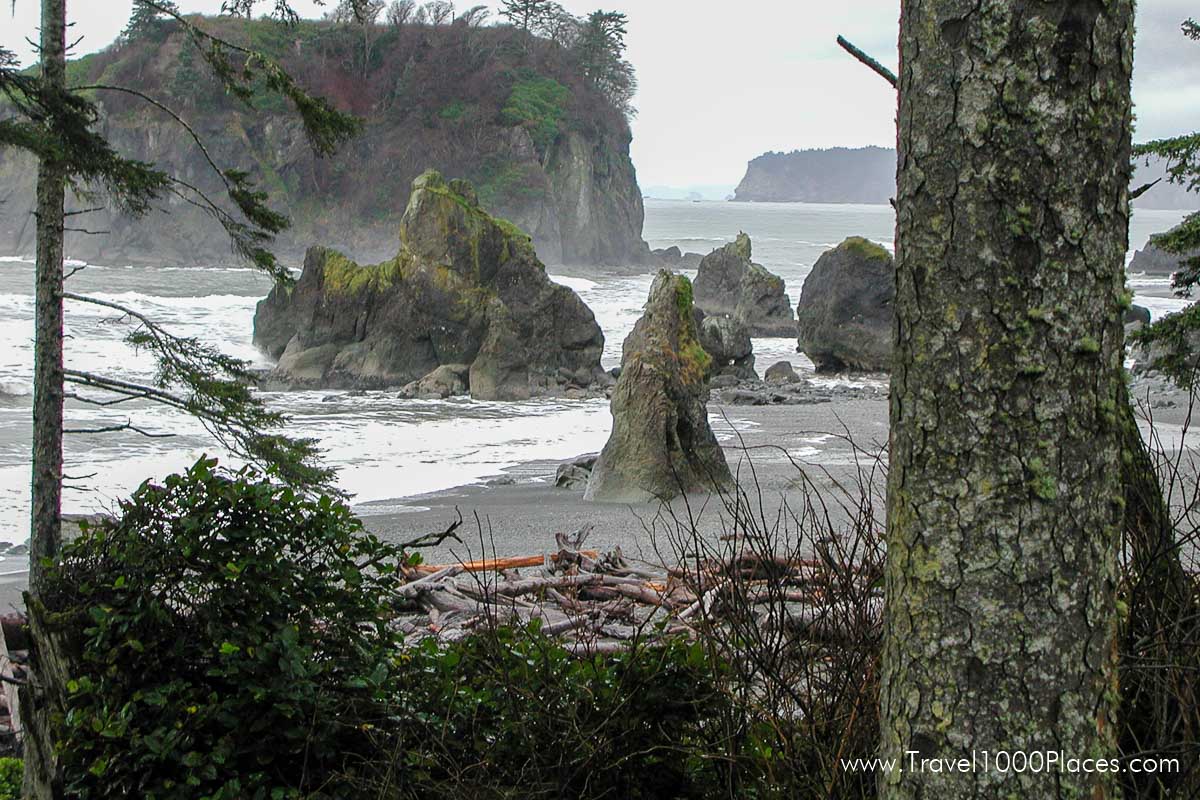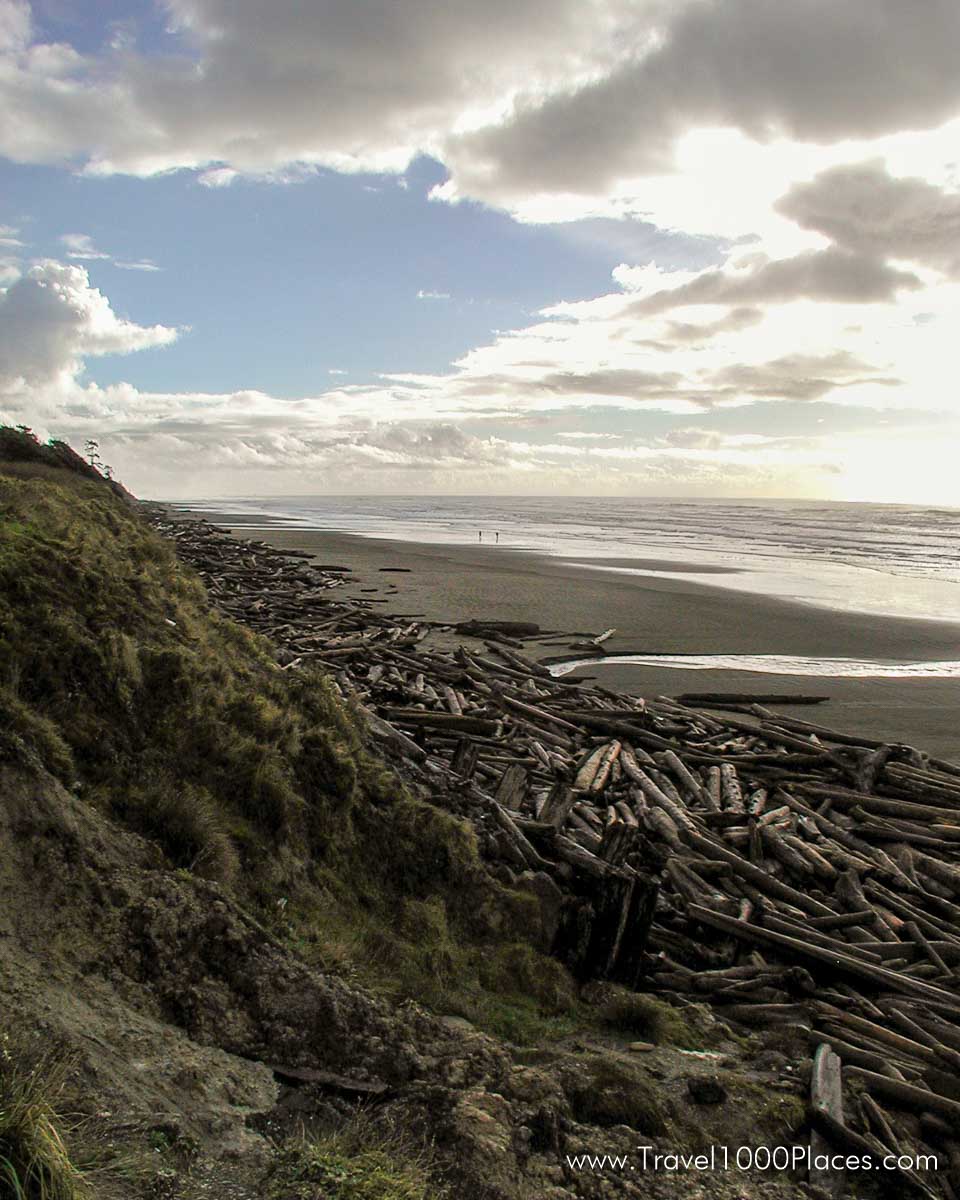
Read more: Overview, map, weather, how-to-get-there, itinerary ideas: Olympic National Park, Washington State, USA
Pacific Coast… First things first
Don’t get trapped by a rising tide! Always carry — and know how to use — a tidetable, topographic map and a watch whenever hiking along Olympic’s coast!
Several points along the coast are only passable at lower tides. Always carry a tide chart, available at visitor centers and coastal ranger stations. DO NOT GUESS! Know when the tides will occur and plan your hike according.
Strong winds or storms can significantly elevate tides and create hazardous conditions. Be attentive to your surroundings and never underestimate the power of the Pacific Ocean.
Mora and Rialto Beach
About an hour’s drive west of Port Angeles, Mora has a campground, self-guided nature trails and a ranger station that’s open intermittently in summer. Another two miles beyond Mora is rocky Rialto Beach on the Pacific Ocean. Picnic tables, restrooms and a trailhead are provided at Rialto Beach.
Facilities: Mora Ranger Station, open intermitttently in summer with information, book/map sales, and bear canisters. Wilderness camping permits year-round. Restrooms (accessible) are at Rialto Beach.
Camping: Open year-round, first-come, first-served, 94 sites, one accessible, one walk-in, (no group site), fire rings with grates, accessible restrooms, water, animal-proof food storage, RV dump station (fee).
Picnic Area: Rialto Beach: paved, several tables with table extensions.
Boat Launch: Dickey River Boat Ramp, not accessible at low tide.
Regulations: Pets are not allowed on the wilderness coast beaches or on any park trails. Pets are allowed on Rialto Beach to Ellen Creek only and must be on a leash at all times.
Severe currents, rocks and infamous weather doomed many ships along this wild coast. Shipwrecked mariners told of hardships endured on the rugged and desolate shoreline, and of dramatic rescues, some involving heroic assistance from local tribes. Memorials north of Rialto Beach commemorate 36 people who died in wrecks of Chilean and Norwegian vessels in 1920 and 1903; testament to a perilous, remorseless sea that has taken many lives.
This coast has seen drama, tragedy and heroism. Shipwrecks stir our emotions and capture the essence of the human struggle against the elements. Even today, with modern navigation and powerful engines, ships have trouble. Accidents have spilled thousands of gallons of oil onto these pristine beaches, killing sea birds and coating rocks and sand. The drama and tragedy continue.
Ruby Beach
A beautiful and impressive wilderness beach with lot of driftwood. A short trail leads from the parking lot (off of US 101 north of Queets) to the beach through dense forest. Best time to visit is during low tide.
Kalaloch Beach

Kalaloch Beach is located only a few miles south of Ruby Beach is is not so much enclosed by rain forest.
Kalaloch Beach is a wide (probably 50 yards during low tide) and long stretch of beach and accessible from the US 101. Several small trails lead down to the beach. Best time to visit is during low tide because much of the beach is flooded during high tide.
Kalaloch means “good place to land” in the Quinault language. This beach was a safe landing place between the Quinault and Hoh Rivers.
Facilities: Kalaloch Ranger Station open daily in summer only. Information, exhibits, sales items.
Concessions: Kalaloch Lodge (360) 962-2271. Open year round. Cabins, rooms, restaurant, coffee shop, dining room, camp store, gasoline, group campsite.
Camping: Kalaloch: 175 sites (four accessible), fire pits with grates, picnic tables, potable water, accessible restrooms, animal-proof food storage, RV dump station (fee). Open year round. South Beach (open late May thru October): 80 sites, tables and fire pits, dirt road, animal-proof food storage, flush toilets, BUT NO WATER.
Regulations: Pets are allowed on Kalaloch area beaches. They must be on a leash at all times. For fishing and shellfish harvest, refer to state and park regulations.
Lake Ozette Area
Although three miles from the Pacific, the Ozette area is a popular coastal access point. A small campground and ranger station (open daily in summer) are located at Lake Ozette. Two three-mile boardwalk trails lead to Sand Point and Cape Alava, both located on the Pacific Coast.
As many as 130 homestead families called Lake Ozette home in the early 1890s. Schools, a post office, stores and a church sustained the farming community.
Life was hard on this remote tip of the country.
When the area was included in the Olympic Forest Reserve in 1897, most early settlers left. A second wave of settlers arrived after the turn of the century. Vestiges of their homesites remain. On the Cape Alava Trail, hikers cross the prairie where Lars Ahlstrom pastured his livestock.
In 1940 a strip of coast and the Ozette area were included in Olympic National Park. Even as forest gradually reclaims once cleared land, stories of early human residents linger.
Facilities: Ozette Ranger Station usually open daily from May through September. Off season hours are intermittent. Picnic area, public telephone. Entrance fees charged year round.
Camping: Open year round, but may be primitive with no water and pit toilet only in winter. 15 sites, accessible restroom nearby. No RV hookups.
Backcountry: Reservations are required for backpacking along the Ozette Coast from May through September. Contact the Wilderness Information Center in Port Angeles (360) 565-3100. Animal-resistant food containers are required for storing food. Raccoons can get into other types of containers! Fires are not permitted between Wedding Rocks and Yellow Banks, including Sandpoint.
Supplies: A small store just outside the park boundary has additional camping, basic supplies and rents food storage buckets.
Regulations: Pets are not permitted on park trails or backcountry areas, including boat-in lake camping. They must be on a leash at all times while in the park. Feeding wildlife is prohibited, for the health of the animals and for your safety.
Trails at Ozette
Trails begin behind the Ozette Ranger Station. Check a tide table to best time your beach hiking. Safety: The boardwalks are very slippery when wet or frosty. Soft soled shoes like tennis shoes or lightweight walkers grip the boardwalk better than stiff hiking boots with hard lug soles. Take your time and walk carefully.
- Cape Alava: 3.1 miles of mostly boardwalk through open prairie and coastal forest to rocky beach.
- Sandpoint: 2.8 miles one way on mostly boardwalk through coastal forest to a wide sandy beach.
- Ozette Loop: Connect the Cape Alava and Sandpoint trails by a 3.1 mile hike on the beach to make a 9 mile loop. Elevation change less than 40 feet.
National Park Service Website
All locations with detail description: Places to Go – Olympic National Park (U.S. National Park Service) (nps.gov)

